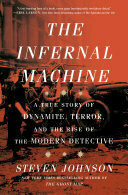
“A fast-burning fuse of a book, every page bursting with revelatory detail.”—ERIK LARSON A sweeping account of the anarchists who terrorized the streets of New York and the detective duo who transformed policing to meet the threat—a tale of fanaticism, forensic science, and dynamite from the bestselling author of The Ghost Map A CHICAGO PUBLIC LIBRARY BEST BOOK OF THE YEAR • LONGLISTED FOR THE ANDREW CARNEGIE MEDAL FOR EXCELLENCE IN NONFICTION • NOMINATED FOR THE EDGAR AWARD Steven Johnson’s engrossing account of the epic struggle between the anarchist movement and the emerging surveillance state stretches around the world and between two centuries—from Alfred Nobel’s invention of dynamite and the assassination of Czar Alexander II to New York City in the shadow of World War I. April 1914. The NYPD is still largely the corrupt, low-tech organization of the Tammany Hall era. To the extent the police are stopping crime—as opposed to committing it—their role has been almost entirely defined by physical force: the brawn of the cop on the beat keeping criminals at bay with nightsticks and fists. The solving of crimes is largely outside their purview. The new commissioner, Arthur Woods, is determined to change that, but he cannot anticipate the maelstrom of violence that will soon test his science-based approach to policing. Within weeks of his tenure, New York City is engulfed in the most concentrated terrorism campaign in the nation’s history: a five-year period of relentless bombings, many of them perpetrated by the anarchist movement led by legendary radicals Alexander Berkman and Emma Goldman. Coming to Woods’s aide are Inspector Joseph Faurot, a science-first detective who works closely with him in reforming the police force, and Amadeo Polignani, the young Italian undercover detective who infiltrates the notorious Bresci Circle. Johnson reveals a mostly forgotten period of political conviction, scientific discovery, assassination plots, bombings, undercover operations, and innovative sleuthing. The Infernal Machine is the complex pre-history of our current moment, when decentralized anarchist networks have once again taken to the streets to protest law enforcement abuses, right-wing militia groups have attacked government buildings, and surveillance is almost ubiquitous.